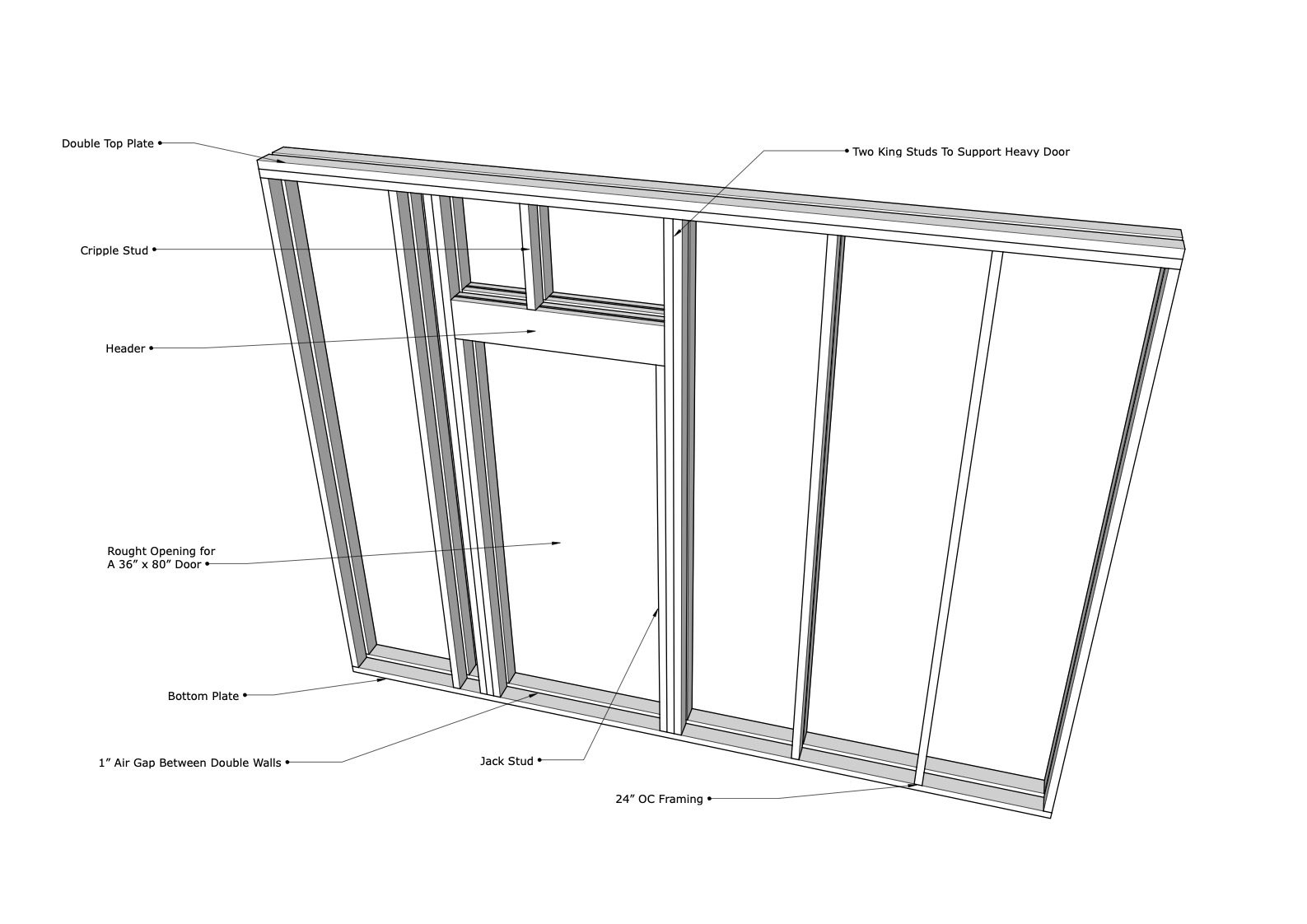How To Soundproof A Door - Part 1
Nov 20, 2023I have done many articles over the years on soundproof doors. Lately, I have changed how I build them from my earlier videos. I am going to do a multi part series on door design and building over the next few weeks. Today will be all about framing the door and where to source your solid core doors.
1) Framing Your Doors
For this example I will be using two interior walls framed with a 1" air gap. The same principles apply if you are using a hat channel system on your walls or have one wall that is interior and one wall that is exterior.
Below is a diagram of how to properly frame a soundproof door. Most of the framing is consistent with normal construction, however we want to add an extra king stud to support each or our 140+ lb doors.

I would recommend 24" OC framing if your wall can handle it. You should calculate the max load your wall can handle before framing 24" vs. 16" OC. From a soundproofing perspective the less wood to transfer sound in anyway the better.
2) Rubber Seals and Sway Bracing
One very strange aspect of a double wall design is how to seal the air gap so that it is still soundproof, but also so that you don't smell or see into the wall cavity between your two doors. The solution is to use rubber. I recommend buying 1/16" x 8" rubber off amazon here in the states. This way your rubber seal will fit your two walls perfectly. Notice the diagrams below.

The rubber should be attached with screws and acoustic sealant to make sure it is airtight. I place the rubber on the outside king studs, because we will be using a prefinished steel door frame that will wrap around the inner jack studs and two layers of 5/8" drywall. The remaining gap between the rubber and inner door frame will be filled with 1" rigid Corning 703 insulation wrapped in Guilford of Maine Acoustic Fabric.
Notice I recommend placing the rubber on top of your header and under the cripple studs. This will cover the 1" air gap at the top of your door. The bottom of the door will have a threshold and the studs will be cut away for entry.

To keep your walls from swaying with the weight of the door we need to add sway bracing to the interior walls. I like to use I-B3 clips from The Soundproofing Company. Place these clips every 48" OC on the top plate of your inside wall and connect it to the ceiling joists. This will still decouple your wall, but provide much needed support to your inner decoupled wall.
3) Doors and Door Hardware
Over the years, I have moved beyond the Rod Gervais book and have begun designing my own system for soundproof doors. This has led me to a great site here in the states called TruDoor. They have everything we need to order all the door parts in one place. The following is what I recommend for each door. Simply double the materials to get your communicating door system.
*If you don't live in the States then do your best to find these similar materials in your own market.
- Paint Grade Primed MDF Solid Core Door - $183
- Neoprene Rubber Strips - $27.89 (for 10')
- Cal-Royal NM Series Mortise Lockset - $206.96
- ABH A110HD Heavy Duty Full Mortise Concealed Continuous Geared Hinge - $85.05
- Pempko 2006STC Acoutic Latching Panic Saddle Threshold with Bumper Seal - $42.10
- Timely Pre-Finished Steel Door Frame - $130
- Zero International Heavy Duty Surface Mounted Automatic Door Bottom - $157.58
- Zero International 770AA Adjustable Perimeter Gasketing Acoustic Door Seal Set - $538.64
Total Door and Hardware Cost - 1,371.22
Total Entryway Cost = 2,742.44
If that number shocks you, then you probably have not researched pre-built soundproof doors. Custom Soundproof Doors can reach the $6,000-8,000 range. The lowest price I have found for a quality soundproof door is $3,260/door. So, you can cheap out on some of the items above, but it will sacrifice your level of soundproofing.
Lastly, this is part one of a multi-part series. The solid core doors only weigh 60 lb so, we will need to add weight to each door. This will add some more costs in materials. We will also need to go over how to install the doors and ensure they are airtight. Stay tuned for part two.
Do You Want To Learn More About Soundproofing?
Join Our FREE Soundproofing Workshop

